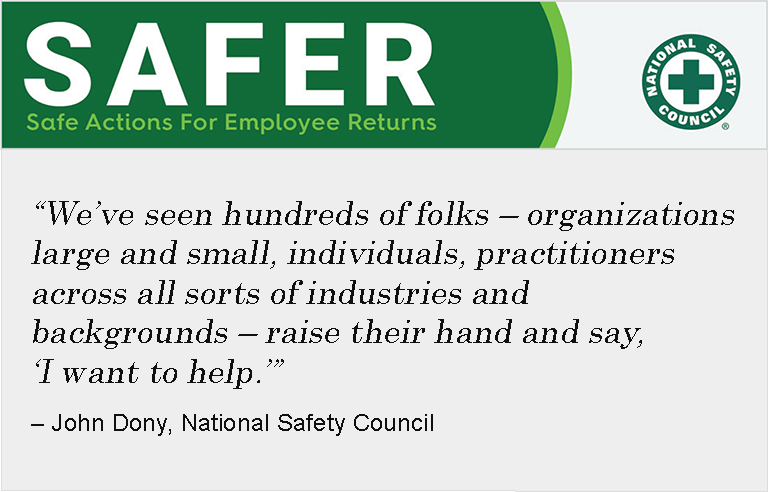SAFER: NSC creates task force to provide guidance on returning to work safely

As traditional work and operations begin to resume amid the COVID-19 pandemic, safety and health are on the minds of employers and employees alike.
To help guide both groups through the process safely, the National Safety Council has launched SAFER: Safe Actions for Employee Returns, a comprehensive, multifaceted initiative that is bringing together nonprofit organizations, businesses, medical professionals, government agencies and trade associations with the intent of developing industry- and risk-specific resources and recommendations for U.S. employers of all sizes.
Although various states, agencies and industry groups have released specific guidance, the council’s goal is to create an all-encompassing set of resources focused on worker safety now and in a post-pandemic environment.
“We saw a lot of good resources being put into the public conversation,” said John Dony, director of the Campbell Institute at NSC and the council’s staff lead on SAFER, “but they were maybe a little narrowly focused or only on one specific issue or type of work environment.
“We have the access to folks not just in industry, but in trade associations and government, and in the medical, HR, and legal communities. Let’s bring them all together and provide something that has more rigor behind it, is more comprehensive and looks at all dimensions of this issue. That was the rationale.”
Guidance developed by the task force will focus on physical and mental health, fatigue, and stress, Dony added.
First steps
Beginning the week of May 4, the SAFER task force began rolling out a return-to-work framework that focuses on how to safely return to work or how essential workplaces can continue to work safely.
Over the next several weeks, NSC is anticipating additional “deeper dive” documents to be published, based on four categories:
- Office environments
- Enclosed industrial (manufacturing, etc.)
- Open industrial (construction, etc.)
- Public-facing environments (retail, health care, utility work, etc.)
“We’ll be really building out the framework with more depth,” said Dony, who added that the task force will expand the guidelines and recommendations based on contributors who have shared their procedures, as well as include various documents from agencies such as OSHA, NIOSH, FEMA and the Centers for Disease Control and Prevention.
“From there, we’ll be iterating these documents as people begin to actually see what it’s like to come back into their (work) environment,” he said.
As the library of documents grows and impacts workplaces, SAFER eventually will be aimed at influencing public policymakers and health officials to ensure worker safety and health.
How to get involved
Dony said organizations of any size can contribute to the initiative, regardless of whether they’re NSC members.
For up-to-date information, visit NSC.org/SAFER and click “Sign up for SAFER resources.” To contribute to the work of the task force, email [email protected].
Along with working with the task force, contributors are needed to review documents and resources or add input during a comment period.
“We’ve seen hundreds of folks – organizations large and small, individuals, practitioners across all sorts of industries and backgrounds – raise their hand and say, ‘I want to help,’” Dony said. “It speaks to the passion and commitment of the safety community.”
Post a comment to this article
Safety+Health welcomes comments that promote respectful dialogue. Please stay on topic. Comments that contain personal attacks, profanity or abusive language – or those aggressively promoting products or services – will be removed. We reserve the right to determine which comments violate our comment policy. (Anonymous comments are welcome; merely skip the “name” field in the comment box. An email address is required but will not be included with your comment.)

